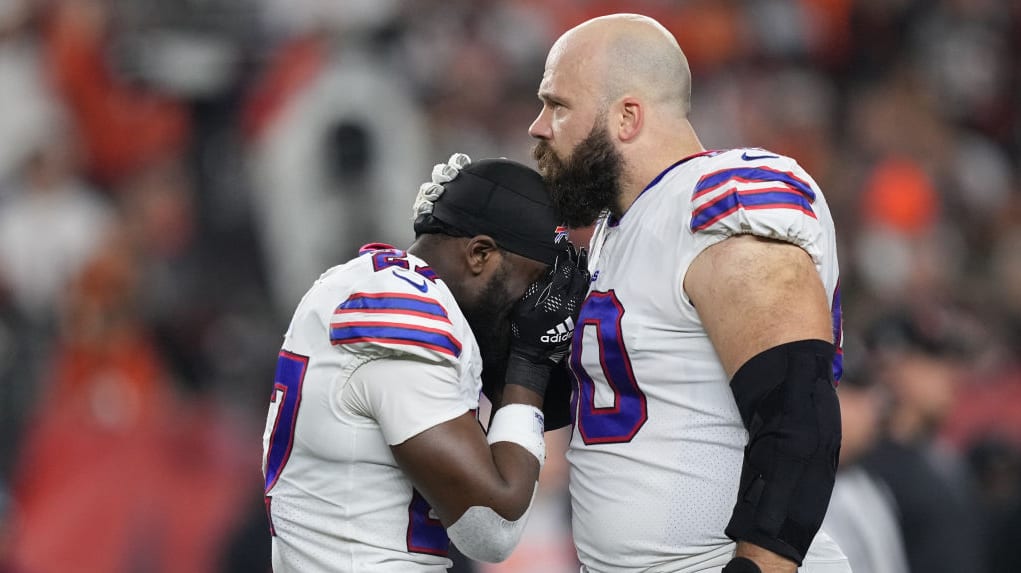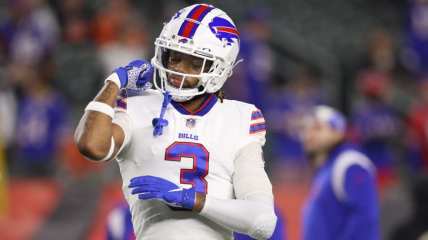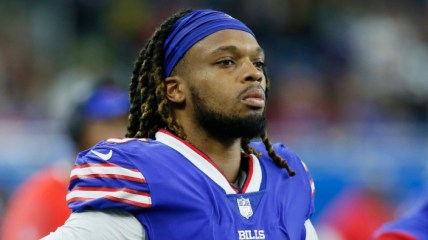How the Damar Hamlin injury unmasked the unlikely outcome we fear most
Football is a violent sport, one that comes with an inherent risk of injury, but most people don’t imagine seeing a life-altering tragedy in real-time.

The harrowing sight of Damar Hamlin — the 24-year-old safety for the Buffalo Bills — collapsing after being involved in a tackle on Cincinnati Bengals wide receiver Tee Higgins, on what appeared to be a routine play, will be the lasting image of the 2022-23 NFL season.
Football is a violent sport, one that comes with an inherent risk of injury, but most people don’t imagine seeing a life-altering tragedy in real time, in part because it seldom happens to young men in the physical prime of their lives. Despite the game’s danger, Frederick “Chuck” Hughes, a former wide receiver for the Detroit Lions, is believed to be the only NFL player to die on the football field. Hughes was 28 when he passed away during week six of the 1971 NFL season.
The exact cause of Hamlin’s collapse remains a mystery, and it may be too early to speculate on the “why” behind this traumatic event, but the fears of so many — family, friends, fellow players, fans, and the NFL brass — have been realized.
What we know is that Hamlin’s heart suddenly stopped beating on the field, a condition known as cardiac arrest. He was unable to breathe on his own, requiring lifesaving CPR and intubation. Medical professionals performed nearly 10 minutes of CPR on the field, in an effort to jump-start the heart and promote blood and oxygen flow to the body. In a statement, team officials later reported that Hamlin had a pulse — a sign of cardiovascular activity. In general, the more time the body spends without oxygen, the more oxygen-sensitive cells in the heart and brain begin to die. CPR and placement of a breathing tube are ways to preserve these tissues.
The defense standout was rushed to the University of Cincinnati medical center, the only level 1 trauma center in the area, five miles away where he was deemed to be in critical condition. His heartbeat was restored on the field, but Hamlin remains sedated.
The cause of Hamlin’s cardiac arrest is unknown, but given his age, some possibilities include a previously undiagnosed heart condition such as an arrhythmia or hypertrophic obstructive cardiomyopathy (HOCM) or the triggering of a cardiac event based due to the impact of a hit sustained during the game. It is conceivable that a hit could displace an atherosclerotic clot causing a blockage in the heart, or trigger commotio cordis — a rare but sudden life-threatening arrhythmia caused by a low or mild chest wall impact.
The second-year safety’s mother was in attendance and accompanied her son to the hospital. She was likely asked to provide information on her son’s past medical as well as any known family history of heart-related disease.
It’s unlikely that medical professionals will know exactly what precipitated this event, but there’s no doubt that the heroic efforts of medical professionals at the game prevented sudden death. The chances of survival after cardiac arrest decrease by 10% for every minute that CPR is delayed, so immediate interventions are necessary. Once a heartbeat and pulse are restored, preserving brain function and preventing end-organ damage to the kidney, liver, and lungs become tantamount.
Official postponement of the game occurred shortly after 10 p.m. — over an hour after Hamlin collapsed — although the game’s suspension seemed to be imminent and hardly in doubt based on the reactions of players, coaches, and on-field game personnel. Twitter-fueled criticism has already begun to reign down on the NFL for what seemed to be a slow decision to postpone the game.
From a medical and human perspective, postponement of a football game should be an obvious and printed policy when CPR is initiated (or there is any indication that a player’s life is at imminent risk). Still, there is so much information that we are not privy to and what the NFL did or didn’t do should not distract us from Hamlin’s current fight. Football is a distant second — in matters of life and death prayer and empathy supersede speculation as we begin to unpack the trauma we cannot unsee.
No one will remember the 7-3 score at the game’s halt or the future outcome of this game. The image of a young man, full of potential and aspirations, falling to the ground, clutching for life … and his teammates’ horrified reaction are now etched in our minds. A host of players (current and former) and football fans, including Patrick Mahomes, Ryan Clark, Ryan Shazier (who experienced a career-ending spinal injury) in 2017, and New York City Mayor Eric Adams have asked for all to join in prayer in support of Hamlin and his family. That seems like a good place to start as we pull for Hamlin’s recovery, but in the interim let this be a reminder to hug your loved ones, count your blessings and live in the present — because tomorrow is promised to no one.

Dr. Shamard Charles is the executive director of graduate studies in public health at St. Francis College and sits on the Medical Advisory Board of Verywell Health (Dot Dash-Meredith). He is also host of the health podcast, Heart Over Hype. He received his medical degree from the Warren Alpert Medical School of Brown University and his Master of Public Health from Harvard’s T.H. Chan School of Public Health. Previously, he spent three years as a senior health journalist for NBC News and served as a Global Press Fellow for the United Nations Foundation. You can follow him on Instagram @askdrcharles or Twitter @DrCharles_NBC.
TheGrio is FREE on your TV via Apple TV, Amazon Fire, Roku, and Android TV. Please download theGrio mobile apps today!


